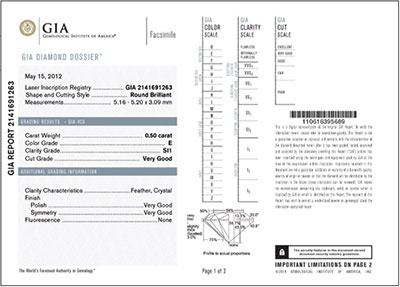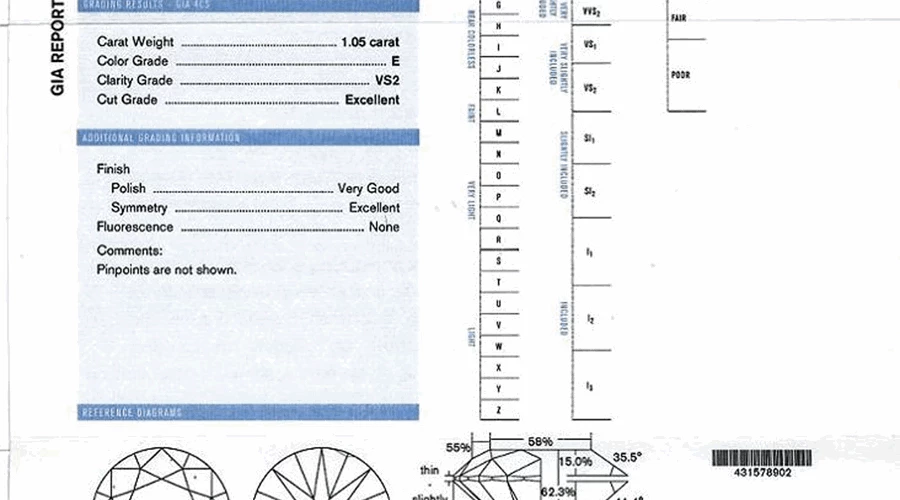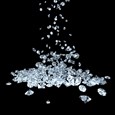Sign up for our Newsletter
Understanding Your Diamond Certificate
We supply the certificate details for each of the diamonds listed on our website so you can check its credentials before making a decision to buy.
Here’s an example of a typical diamond certificate and a guide to all the various sections.

Shape and Cutting Style
This simply states the shape of the diamond, e.g. Round Brilliant. Information about all the different diamond shapes can be found in our Diamond Shapes section.
Measurements
Diamond measurements are always given in millimetres (mm).
For round diamonds, the measurements are shown as minimum diameter - maximum diameter x depth, e.g. 8.14 - 8.18 x 5.60. Be wary of any round diamond where there is a significant difference between the minimum and maximum diameters as this will affect the diamond’s roundness.
For all other shapes (fancy shapes), the dimensions are shown as “length x width x depth”.
You can work out the length to width ratio of any diamond by dividing the length by the width. So for example, an Emerald cut diamond measuring 12.3 x 11.2 x 8 has a length to width ratio just short of 1.10. See Diamond Shapes for our recommended length to width ratios for each shape.
Carat Weight
The carat weight of the diamond - how much it weighs. For more information see Carat Weight.
Colour Grade
The colour grade of the diamond - how close it is to colourless. For further details see Colour.
Clarity Grade
The clarity grade of the diamond - how many inclusions and blemishes it has. For find out more see Clarity.
Cut Grade
The cut grade of the diamond. As there are no universally accepted standards for cut grading fancy (not round!) diamond shapes, this will only appear on the certificate for Round Brilliant diamonds. For all other diamond shapes we assign a cut grade based on table and depth percentages, polish, symmetry, and length to width ratio. For more information see Cut Grade.
Finish
Finish refers to the quality of the surface appearance of the diamond. It covers both polish and symmetry.
Polish
Each diamond is polished after it has been cut to improve the appearance of the facets and to give it a smooth finish.
The polish grade reflects the quality of the finish - how smooth it is and whether any marks have been left from the polishing process itself. The grade given is based on the surface appearance of the diamond at 10x magnification. Although the exact terminology varies depending on the grading laboratory, polish is typically graded on a scale of Excellent to Poor.
Tiny scratches on the surface of the diamond that are visible to the unaided eye may be a sign of a rushed or careless polish. In the same way that a marked or scratched window will restrict light entering a room, any marks on the surface of the diamond can affect a diamond’s light performance and limit the amount of sparkle it’s capable of. However, the influence of polish on light performance is very slight so you only need to make sure your chosen diamond is rated Good or better.
Symmetry
Symmetry refers to the arrangement of a diamond’s facets. Ideally, this should be perfectly symmetrical but sometimes there are minor flaws, barely noticeable to the unaided eye, which may affect how the diamond reflects and refracts light.
When grading for symmetry, the certifying laboratory will examine the shape, placement and alignment of the facets, as well as the overall outline of the stone.
Some common symmetry flaws include a wavy girdle, off-centre table or culet, crown and pavilion not properly aligned, extra facets or ‘naturals’ (remnants of the original diamond rough), and misshapen facets.
As with polish, the exact grades used vary depending on the certifying laboratory, however, symmetry is typically graded on a scale of Excellent to Poor. Although symmetry flaws can affect light performance, any major problems would affect the cut grade so any well-cut diamond with a symmetry rating of Good or better is good enough.
Fluorescence
Diamond fluorescence refers to the effect that ultraviolet (UV) light has on a diamond. When some diamonds are exposed to UV rays, they emit a visible blue light which ranges in intensity from barely discernible to a strong, bright glow. On the certificate, fluorescence will be noted as None (or Inert), Faint, Medium, Strong or Very Strong. About a third of all diamonds display some fluorescence.
In general, fluorescence doesn't have any effect on a diamond’s appearance under natural lighting conditions and most people can’t tell the difference between a diamond with fluorescence and one without. The only reason it’s noted on the certificate is because it can be used for identification purposes alongside other characteristics. If you’d rather not have it though, look for a diamond with no or faint fluorescence.
Proportions
Most certificates contain some reference to the diamond’s proportions - table and depth percentages, crown and pavilion angles, girdle thickness and culet. Depending on the certifying laboratory, these may be simply listed or shown in diagram form.
Table Percentage
Indicates the size of the table in relation to the width of the diamond. For more details see our article on Light Performance.
Depth Percentage
Indicates the overall depth of the diamond in relation to its width. For more details see our article on Light Performance.
Crown Angle
The angle at which the crown meets the girdle.
Pavilion Angle
The angle at which the pavilion meets the girdle.
Girdle
States the thickness of the girdle.
Girdle thickness is usually rated on a scale of Extremely Thin to Extremely Thick. If the girdle is described as Extremely Thin or Very Thin it has a high risk of chipping during prong setting. At the other end of the scale, Thick, Very Thick, and Extremely Thick girdles can ‘hide’ carat weight making the diamond appear smaller than its carat weight should merit.
The ideal girdle thickness to look for is in the middle of the scale - Thin, Medium, or Slightly Thick.
Very often, girdles have thick parts and thin parts (where the facet edges meet the girdle) so it’s normal to see two girdle thickness's given on the certificate, e.g. Medium to Slightly Thick.
Culet
Notes whether a culet is present and how big it is. The typical scale used to describe culets ranges from Extremely Small to Extremely Large. Very Small, Small, or Medium culets are preferred because they’re not visible to the unaided eye, whereas Large to Extremely Large culets can look a bit like an inclusion when viewed through the table.
Very often the culet is pointed or ‘closed’ which means it a flat horizontal facet has been cut and then shaped into a new point, effectively creating a multi-faceted culet.
How do I know that the diamond I'm getting matches the certificate?
Each diamond grading report bears a serial number which you can use to verify its authenticity on the certifying laboratory’s website. If in doubt, you can use this to double-check that the details we supply about the diamond match what’s shown on the certificate.
-
Ethically Sourced Diamonds
-
Handmade in the UK
-
FREE Shipping Worldwide
-
60 Day Returns



